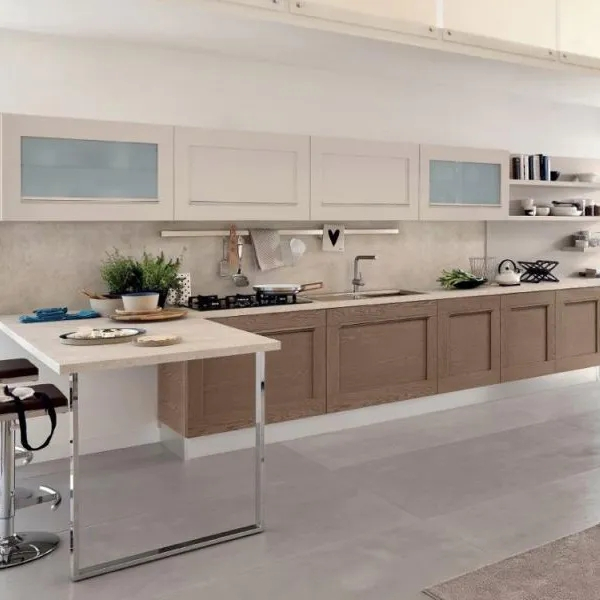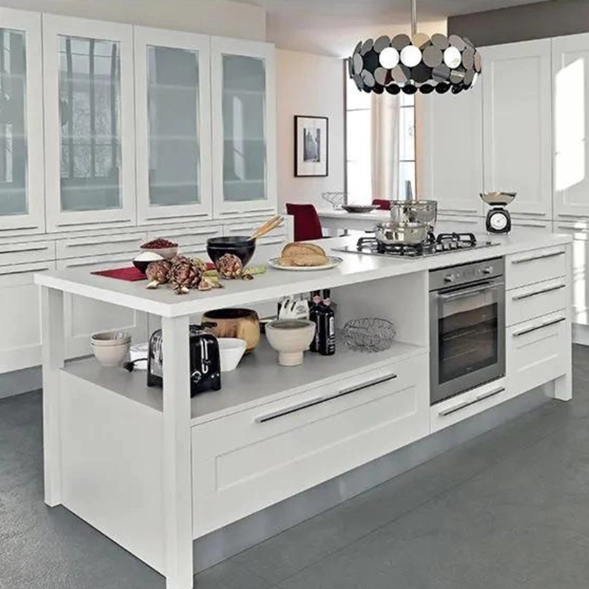Author: Site Editor Publish Time: 10-17-2025 Origin: Site








As the core functional area of a home or commercial space, the kitchen plays a vital role in both utility and aesthetics. Kitchen cabinets not only serve as essential storage solutions but also directly affect the kitchen’s functionality and lifespan. Choosing the right material involves considering factors such as water and moisture resistance, durability, ease of installation, maintenance costs, and compatibility with the overall interior style.
MDF (Medium-Density Fiberboard) and PVC (Polyvinyl Chloride) are two of the most commonly used materials on the market today, each with its own advantages and ideal applications. Understanding their differences is crucial for both residential renovation and commercial kitchen design.
MDF is made from wood fibers bonded with adhesive under high temperature and pressure. Its uniform fiber structure ensures even density and a smooth surface, making it ideal for painting or lamination, with a wide range of textures and color effects available.
Key Properties
Water Resistance: MDF tends to swell or deform when exposed to moisture. To ensure durability in kitchen environments, surface treatments such as lamination or waterproof coatings are recommended.
Strength and Load-Bearing: MDF has moderate strength and can support standard kitchenware, but additional reinforcement is advised for heavy wall-mounted cabinets.
Workability & Customization: Easy to cut, drill, and shape — ideal for customized designs such as curved doors or decorative carving.
Environmental Safety: High-quality MDF uses low-formaldehyde adhesives, meeting environmental standards and minimizing indoor air pollution.
Applications
Residential Kitchens: In dry environments, MDF cabinets can last over 10 years.
High-End Custom Kitchens: Suitable for achieving premium surface effects such as matte, gloss, wood grain, or multicolor finishes.
Not recommended for: High-humidity or open kitchens that require frequent cleaning, as the material may swell or crack

Material Overview & Features
PVC is a synthetic plastic material used for either full PVC cabinets or as a decorative film on MDF/particleboard. Naturally waterproof, moisture-resistant, and corrosion-resistant, it performs well in humid environments.
Key Properties
Waterproof & Moisture-Resistant: Resistant to steam and liquid splashes — ideal for open or near-water kitchen areas.
Durability: Does not rot or crack and maintains structural integrity over time.
Easy Maintenance: Smooth surface allows easy cleaning with no need for additional coatings.
Strength & Structure: Due to lower density, PVC is slightly less strong than MDF and requires appropriate structural support for heavy loads.
Environmental Safety: Proper selection of additives is crucial. High-quality PVC meets international environmental standards such as RoHS and REACH.
Applications
Humid or Open Kitchens: Excellent moisture resistance.
Commercial Kitchens: Easy to clean and maintain; withstands frequent use.
Budget Projects: Cost-effective with long-term savings.

MDF cabinets made with low-formaldehyde adhesives (E0/E1 grade) are environmentally friendly and safe for indoor air quality. Premium MDF utilizes wood by-products, increasing resource efficiency, and some products are FSC certified, supporting sustainable practices. Proper ventilation and moisture control can significantly extend their lifespan.
PVC cabinets, when made with high-quality plasticizers, comply with RoHS and REACH environmental regulations. Their natural resistance to water and corrosion ensures a long service life, reducing material waste from frequent replacements. Some high-end PVC materials are recyclable, aligning with green design principles.
Performance Dimension | MDF | PVC |
Water & Moisture Resistance | Low, requires surface treatment | High, naturally waterproof |
Appearance & Texture | Premium look, customizable finishes | Smooth and easy to clean, but more plastic-like |
Load-Bearing Capacity | Moderate, suitable for light to medium loads | Slightly lower, needs structural reinforcement |
Durability | Moderate; prone to swelling in humidity | High; moisture-proof, corrosion-resistant |
Workability & Customization | Excellent; easy to cut, carve, or shape | Moderate; limited to surface color changes |
Cleaning & Maintenance | Requires care to avoid water damage | Simple; wipe clean directly |
Price | Medium | Low to Medium |
When choosing between MDF and PVC kitchen cabinets, consider the following factors:
Humidity: Choose PVC for humid or open kitchens.
Design Needs: Choose MDF for sophisticated, customized, or high-end finishes.
Durability & Maintenance: PVC offers low-maintenance longevity.
Budget: PVC provides better cost efficiency; MDF suits premium aesthetics.
Usage Frequency: For high-traffic commercial kitchens, PVC is ideal; for residential use, MDF is appropriate.
Both MDF and PVC have distinct advantages. The key lies in matching the right material to your kitchen’s environment, design requirements, budget, and durability expectations.
MDF: Elegant, customizable, and ideal for premium finishes — but requires moisture protection.
PVC: Waterproof, low-maintenance, and cost-effective — best for humid or open kitchens.
With proper material selection and installation, both can ensure a long-lasting, safe, and stylish kitchen while minimizing maintenance costs.
If you’re planning to remodel or upgrade your kitchen cabinets and want expert guidance on choosing between MDF and PVC, contact the Summit team today — our professional designers will help you create your ideal kitchen!
Q1: Is MDF easy to swell or deform due to poor water resistance?
A1: Raw MDF is not waterproof and can swell or crack when exposed to water. However, with quality waterproof coatings, lamination, or UV surface treatment, its moisture resistance greatly improves. In dry areas, its lifespan can exceed 10 years with proper installation and maintenance.
Q2: Is PVC prone to cracking or poor in load-bearing capacity?
A2: PVC is lightweight and less rigid than MDF, but when designed with proper internal supports (e.g., reinforcements or thicker panels), it can easily handle typical household or commercial kitchen loads. Its main strengths are waterproofing, corrosion resistance, and low maintenance.
Q3: Which material is easier to clean — MDF or PVC?
A3: PVC is smoother, waterproof, and stain-resistant, making it the easiest to clean. MDF with a laminated or coated surface is also easy to clean but should not be exposed to water or harsh chemicals for long periods. Overall, PVC is more maintenance-friendly.
Q4: Does PVC offer limited color and texture options?
A4: While MDF allows more customization through painting, lamination, and carving, modern PVC surface technology now provides diverse finishes such as wood grain, matte, gloss, and metallic looks — sufficient for most contemporary kitchen styles.
Q5: Which material is more environmentally friendly?
A5: High-quality MDF uses low-formaldehyde adhesives meeting E0/E1 standards and is safe for indoor air quality. PVC requires careful additive selection — certified, eco-friendly PVC products that meet international standards are safe and sustainable.
Q6: Which is better for a limited budget — MDF or PVC?
A6: PVC is generally more affordable and requires minimal maintenance, making it a great value for durable, cost-efficient projects. MDF costs slightly more but delivers superior aesthetic and customization options, ideal for upscale kitchens.
Q7: Can MDF and PVC be used together?
A7: Absolutely. For example, MDF can be used in dry areas for enhanced visual appeal and texture, while PVC is ideal for humid zones such as under the sink or near open kitchen areas. Combining both materials achieves a balance between aesthetics and functionality.